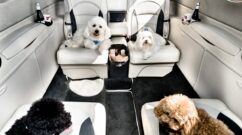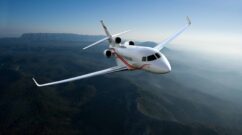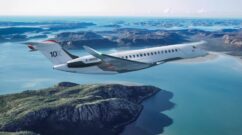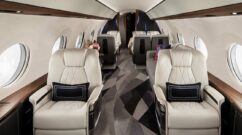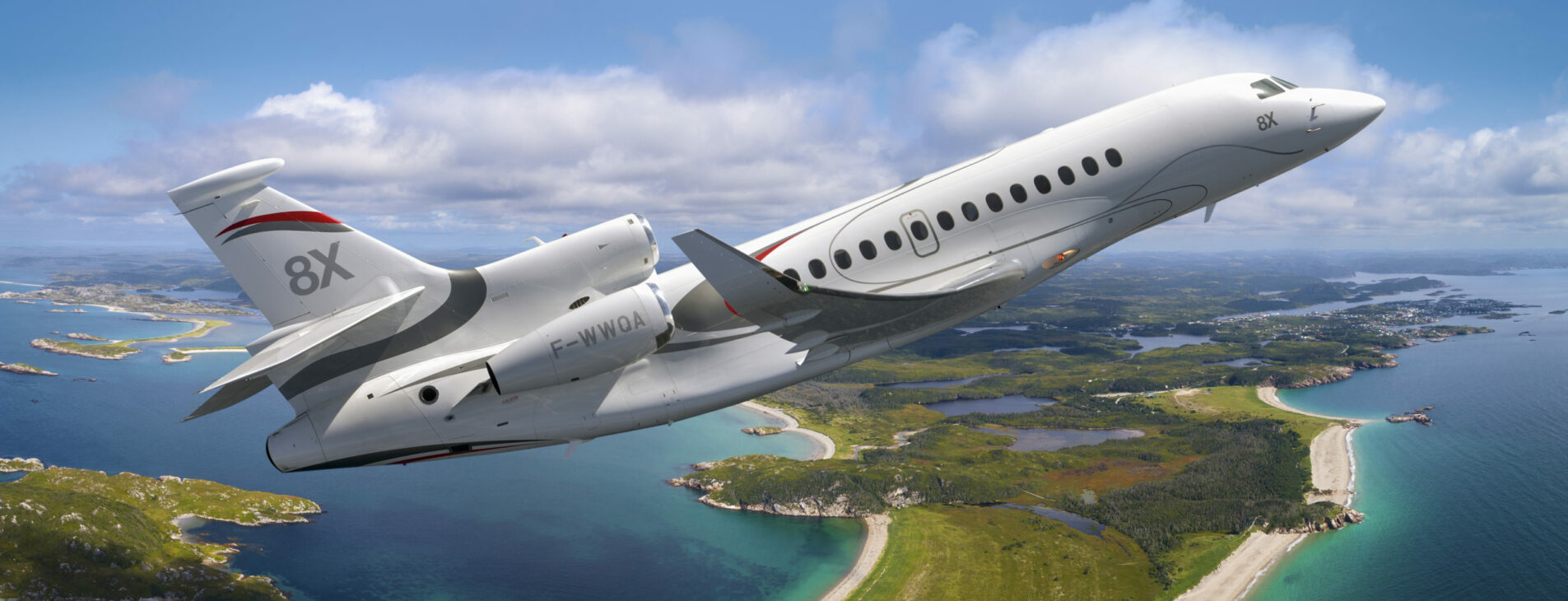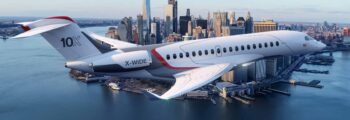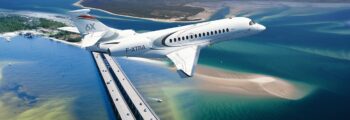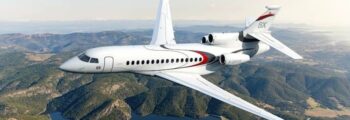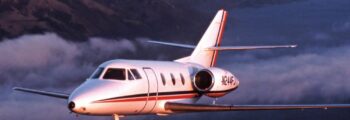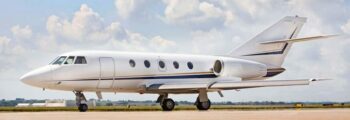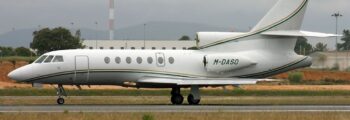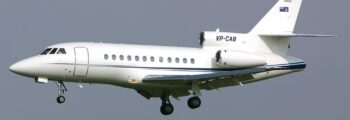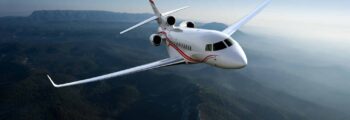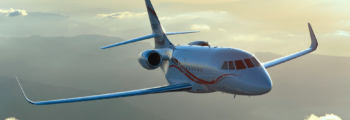Dassault Aviation is a French aerospace manufacturer. This industrial group was established in 1929. It was founded by Marcel Dassault. Within the aerospace industry, it specializes in air transport and notably produces military aircraft, as well as private jets intended for business aviation.
We tell you everything about the history and achievements of this French company: from its first aircraft to the very latest Falcon 10X.
Today, Dassault Aviation, with a revenue of 7.2 billion euros in 2021, has 12,371 employees. 75% of them work in France.
The aerospace manufacturer announces 2,100 Falcons and 1,000 combat aircraft in service.
The company is included in the 2023 ranking of the 100 most socially responsible companies. (source: Statista Institute)
A committed Falcon manufacturer:
The company is committed on several levels:
– Climate and environmental commitment: Dassault Aviation is part of the ICAO Environmental Protection Committee (International Civil Aviation Organization). In this context, they commit to working towards carbon neutrality by 2050. The aerospace manufacturer is committed to using sustainable fuels (SAF). The Dassault company also participates in the Clean Sky research program to find alternatives to reduce fuel consumption.
– Social: the aircraft manufacturer promotes equal opportunities and diversity. The company aims to retain its employees through an attractive and motivating social model.
The history of Dassault Aviation
Dassault Aviation is a branch that depends on the Dassault group (like Dassault Systèmes or Immobilière Dassault, for example). Its founder, Marcel Dassault, was born Marcel Ferdinand Bloch. For the record, he changed his last name from “Bloch” to “Dassault” in 1949. This name was derived from the code “chardasso” used by his brother, a general during the Resistance. Moreover, the Dassault Aviation company only took this name in 1990 (it was previously called AMD-BA).
The origins of Dassault from 1918:
– 1918: At the end of World War I, Marcel Dassault (still known as Bloch at that time) created the SEA: Société d’études aéronautiques. They made deliveries of 300 two-seater warplanes intended for the French Air Force.
– 1930: A team change is made and together they create a new range of aircraft: combat aircraft for the French army:
– a three-engine postal aircraft
– a heavy bomber
– a transport aircraft which is four-engine
– a single-seat fighter
All these aircraft are called MB, followed by a number based on the model.
– 1938: Before being caught in the gusts of World War II, Marcel Dassault founded a new factory in Saint-Cloud in the Paris region. This is today the main design office of the industrial group. In this factory, he will create propellers, as well as engines.
The history of Dassault Aviation continues after World War II:
– 1945: This year marks a new setup and expansion of Marcel Dassault’s factories. A factory in Boulogne will be renamed “Boulogne Avions Marcel Bloch” and a factory in Talence (Nouvelle-Aquitaine) is named the same. Finally, his main factory in Saint-Cloud adopts the same nomenclature, a sign of unity of the aerospace group.
– 1947: New aeronautical creations emerge, including the Mystère-Étendard family. Exports of some models take place in Israel and India. These are the first French exports in the aeronautics sector.
It is during this period that the Mystère II, created by the aircraft manufacturer, becomes the first aircraft to break the sound barrier. This attracts interests as the United States (following an agreement with NATO) places an order for more than 220 aircraft.
– Between 1949 and 1952: New factories open, notably in Mérignac (Nouvelle-Aquitaine), but also in Villaroche (Île-de-France).
– 1955: Marcel Dassault deems it good to concentrate all his businesses in the Saint-Cloud one, which will be managed by Benno Claude Vallières.
– 1956: The Mirage family of aircraft gradually takes shape and increases its exports. These aircraft are real advances in aeronautics and engineering. The Mirage III then reaches the supersonic speed of Mach 2.
Dassault Aviation enters the business aviation market:
– 1960: This marks the beginning of the delivery of civil aircraft. Emerging from technologies used in military aircraft, the Mystère-Falcon enters the market. It is the first twin-engine business jet from Dassault. It quickly conquers the American market as American airlines like “Pan Am” rush to order devices.
– 1971: Following the acquisition of Bréguet Aviation, the Dassault company expands its activities to several military aircraft development programs, such as:
– aircraft for maritime patrol
– the Alpha Jet (jets of the Patrouille de France)
– combat aircraft such as the Mirage 2000, which benefits from the assembly of true cutting-edge technologies.
– 1974: It is in the United States, in Little Rock, Arkansas, that the Dassault Falcon Jet factory opens. This factory is entirely dedicated to the Falcon business jet family.
The succession of the company:
– April 1986: Marcel Dassault passes away, leaving as heir Serge Dassault, his son, who then takes the helm of his company.
– 1987 – 1996: During about ten years of the global decline in the aerospace sector, the Dassault company unfortunately has to restructure and reduce its workforce. During these years, almost 60% of the employees had to leave the company.
– 1993 and 1995: respectively the first flights of the Falcon 2000 and the Falcon 900EX.
– 1999: An important date, as Dassault Aviation, then a military aviation specialist, sees its revenue reach 68% in the civil aviation sector.
The arrival and use of computers in the production of Dassault aircraft:
– 2000: Serge Dassault leaves his position as CEO, Charles Edelstenne succeeds him.
– 2000 – 2015: Technological evolution with the arrival of computing allows the manufacturer to model their models directly in virtual form. This allows simultaneous work of teams, thereby saving considerable time and increasing productivity. It is during this time (in 2005) that the prototype of the Falcon 7X, a tri-jet, is machined and made directly operational, without any modifications.
– 2013: Eric Trappier becomes the new (and current) CEO of Dassault Aviation.
– 2016: The Dassault Falcon 8X makes its first flight on the business aviation market. Meanwhile, the Rafale fighter jet is exported and sold internationally. Symbol of air combat. 36 Rafales were delivered, and their landing took place in India that year.
– 2021: The Falcon 6X takes to the skies for the first time (after the cancellation of the Falcon 5X project). This year is also marked by an impressive revenue of 3.1 billion euros, notably generated by numerous Rafale placements. In mid-2021, Dassault Aviation presents the Falcon 10X.
– 2025: As announced by the company, in 2025 we hope to see the arrival of the Falcon 10X on the market.
The public appearance of Dassault Aviation:
The French aircraft from Dassault have a good reputation and have already made numerous public appearances. Indeed, for the July 14 parades, the following have already appeared over the years:
– the Dassault Mirage 2000
– the Dassault Falcon 50
– the Dassault Super-Etendard
– the Dassault Rafale.
They are observed passing every year between the Champs Elysées roundabout to the Place de la Concorde. (During several years, this parade could also take place from the Place des Invalides in Paris to the Place de la Concorde, as in 1913 or 1930, for example).
You will have noticed, the aerospace group of Dassault operates in several sectors and industries. It occupies both an aerospace activity in civil and military aviation but also in aerospace.
The aerospace activity of Dassault Aviation:
The French company manages both a creation activity of space vehicles and also pyrotechnic missions. The 3 space vehicles that have been created have different purposes.
Firstly, they aim to study the feasibility of transport in order to launch a satellite into low orbit. This is thanks, in part, to an air-launch.
Other aspects such as aerodynamics and thermodynamics are studied on shuttles already in space.
In terms of pyrotechnic activities, Dassault Aviation is a true aerospace equipment manufacturer. It machines numerous spare parts, as well as systems and equipment intended for aircraft. In addition, once the testing phases are completed, these achievements are used on satellites, for example. However, they are also used on launchers such as Vega or Ariane, and even on launchers outside Europe.
The military aerospace activity of Dassault Aviation:
The Rafale, a twin-engine combat aircraft committed to national defense with its aeronautical programs, has long been constructing its emblematic fighter aircraft: the Rafale Dassault.
This jewel of military aviation made its first operational flight in 1986. Exceptional, this military aircraft is versatile and can perform several tasks simultaneously, all during a flight. It is capable, for example, of carrying out defense missions, while also performing aerial reconnaissance and surface attack procedures. Pilots do not have the right to make mistakes. This is the case when they take off from an aircraft carrier, where the runway is very short. Fortunately, the aircraft benefits from ejection seats.
A true police of the skies in case of conflict, the Rafale asserts its characteristics of survivability and stealth at all times. It also has self-protection tools as well as an enriched range of armaments, essential in high-risk areas. It is the elite of the French fighter aircraft.
Finally, the performance of this military aircraft is also observed in the supersonic speed achieved by the Rafale. With a maximum speed of 2223 km/h, or Mach 1.8.
Dassault and its military support mission:
This is a mission that the aircraft manufacturer operates in the defense sector. Indeed, it provides assistance in several aspects, both logistical and technical.
Their follow-up of actions takes place on the approximately 1,000 military aircraft operating within the French Air Force, but also abroad. Dassault commits to supporting the aircraft during their lifespan, which is approximately 40 years. The company supports different types of delivered aircraft such as:
– the Rafale
– the Alpha Jets (aircraft of the Patrouille de France)
– the various models of the Mirage range.
The Neuron program:
The French company has been managing the Neuron program (nEUROn) since 2006.
This is a European program aiming at the creation of a military aircraft that would contain no pilot or crew. Its initial objectives are primarily based on innovation and technological challenges.
For now, the aircraft manufacturer wants to confirm the aeronautical technology implemented to control and activate an unmanned military aircraft.
Several goals have already been achieved during demonstration flights. Among others, the aircraft is capable of autonomously assessing threats both on the ground and in the air, as well as locating and identifying, etc.
This project evolves over time and seeks to expand its technological competency so that this autonomous military aircraft is at the forefront of innovation.
The multi-mission Falcons:
They are called multi-mission Falcons because they can be requisitioned for both military missions and civil functions. These aircraft have a long range.
In this category, you will find:
– the Falcon-Marine
– the Falcon 2000MRA
– Falcon 900MPA.
These aircraft have wide fuselages. The possibilities for different fittings, as well as adaptation to all types of missions, are thus carried out more optimally. Each aircraft adapts and fulfills different missions such as:
– surveillance
– military equipment cargo
– maritime interventions
– towing
– medical evacuations.
The civil aerospace activity of Dassault Aviation:
The Falcon family:
When you hear the name Falcon, you are certainly looking at a family of civil aircraft intended for business aviation. You won’t find a single airline aircraft at Dassault. For about fifty years, this production of business aircraft meets many criteria and offers a broad range in terms of travel. This family of business jets is, moreover, among the leaders in the range of large cabin private jets.
Some key figures of Dassault Falcon:
The large Falcon family signifies both a guarantee of quality, safety, whose reputation is well established in the aeronautics market. These few figures bear witness to this:
– 2500: the number of Falcon aircraft in circulation today.
– 80: represents the number of countries in the world that own a Falcon business jet.
– 16 million: these are the cumulative flight hours for the 2500 Falcons (for informational purposes, this represents almost 8 months of non-stop flight per jet!).
To maintain all these aircraft, nothing beats the Falcon Dassault Service, one of the largest maintenance sites located in Paris Le Bourget. There is nothing better than attending the Bourget show to see it with your own eyes.
The common points and advantages of the different Falcons:
The Falcon family has a considerable advantage because it benefits from the acquisitions made on military aircraft that Dassault has manufactured previously.
Private jets with a high level of technological innovations:
Indeed, this represents considerable advances in technological innovation. These evolutions are notable, particularly on the systems present in the cockpit, but also in terms of the aerodynamics of business aircraft or on improving flight quality.
The Dassault Falcon planes emit less CO²:
In addition, with a focus on reducing CO2 emissions, all Falcon business jets certify an average consumption of 30 to 50% less than their counterparts. Therefore, Dassault Falcons are among the least polluting aircraft (with the least CO2 emissions) in the business aviation market.
The Falcon private jets have recognizable design and comfort:
Besides performance, it is also in terms of aesthetics, functionality, and design that Falcon stands out. Indeed, the cabins of these private aircraft offer a remarkable and noted comfort.
It is worth noting Dassault Aviation’s constant adaptation to offer and renew its interiors to meet the most demanding needs. This is, for example, the case of the Falcon 8X, whose cabin was redesigned and reinvented 5 years after its first entry into service.
The Falcon business jet fleet of Dassault Aviation:
We invite you to discover further information and technical details about the different aircraft of the Falcon family at the end of this article. But here is already a presentation of Dassault’s fleet of business jets.
Falcon 900LX:
In the line of Falcon 900, this one was certified in 2010. With a range superior to its predecessors, this long-range business jet can fly from Moscow to New York, or from Beijing to Paris.
This tri-jet carries 6 passengers in unparalleled cabin comfort.
Falcon 2000 (models S and XLS):
Having obtained their certification in 2013, these aircraft are among the leaders in the category of “Super Midsize jets”.
Capable of accommodating between 8 and 12 passengers, these planes can make non-stop flights like Paris-Marrakech. They have a range of about 6000 to 7000 km.
Falcon 7X:
Put into service in 2005, there are already more than 270 Falcon 7X in circulation today. With a range of over 11,000 km, this business aircraft can carry up to 14 passengers over long distances.
High-end private jet, combining speed and comfort, everything is designed to ensure you have a pleasant journey.
Falcon 8X:
Launched in 2016, the Falcon 8X has recently been revamped in its cabin. Dassault Aviation thus confirms its desire to adapt and best meet its clients’ expectations. The Falcon 8X can travel a long-haul distance of nearly 12,000 km. You can fly from Paris to Hong Kong non-stop.
Falcon 6X:
The latest aircraft in the Falcon family arrived on the market in 2021, making its first flight.
At the forefront of technology, it has become an unprecedented reference in business aviation. It offers advanced versions, particularly on the flight controls. It also provides you with a long-haul journey in total comfort, with a capacity to accommodate 16 people on board.
Falcon 10X:
This one has been announced for arrival in 2025. The Falcon 10X promises multiple unprecedented feats. The most spacious cabin in business aviation and a range of nearly 14,000 km, this is what this private aircraft will accomplish in a few years.
The main challenges and values of Dassault Falcon in business aviation:
With nearly 17,000 private jets in circulation worldwide to date, it is important to stand out. And, this is what Dassault does by promoting values specific to business aviation.
– Flexibility: Travel where you want, when you want! Business aviation adapts to all types of situations and constraints.
– Time savings: according to studies, on average, it saves 2.5 hours on a journey by private jet (compared to commercial flights). This time savings can even reach 5 hours. In a world where time is money, there is no doubt that business aviation is the solution. Dassault places great importance on ensuring that its aircraft are operational in a minimum of time.
– An optimal working environment: why offer cabins that are even more designed, calm, and connected? Because they can sometimes be true workplaces. Holding a meeting in a private jet? It’s absolutely possible. The optimization of time is correlated to the optimization and comfort of passengers in the cabin. That’s why Dassault Aviation updates its private jet interiors (like the recently revamped Falcon 8X).
– Productivity tool: as stated above, in business aviation, time is precious. Thanks to everything private jets offer in terms of technology and comfort, there is no doubt that focus and performance are at the forefront.
At AEROAFFAIRES, we do everything possible to choose the business jets that suit you. If you wish to book your private flight on a Dassault Aviation private jet, contact us at +33 (0) 1 44 09 91 82, or fill out our online quote. Our aviation experts will respond to your request.
